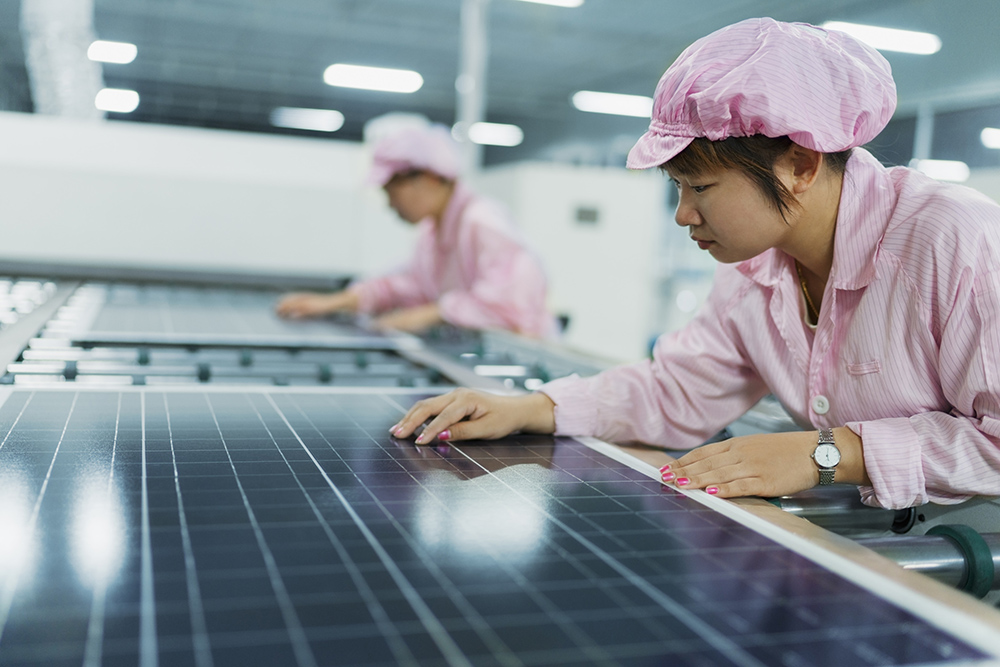Each chemical component and material used in constructing a solar panel is essential for the successful and effective conversion of sun energy into electrical output. Most solar panels that are made from photovoltaic cells or silicone cells are made mostly of crystalline silicon chips. To protect the delicate silicon cells on solar panels while still allowing light to pass through, a coating of glasses and an anti-reflective covering is commonly used.
There are three popular varieties of solar panels:
- Thin film solar panels, which are flexible and created without crystalline wafers,
- Monocrystalline silicon panels/ monocrystalline solar panels are made from a single crystalline
- Polycrystalline is formed by putting together multiple layers of crystals.
What Are Solar Cells?
A solar cell is a technological innovation that directly converts sunlight into electricity through the photovoltaic effect, creating electrical charges that are free to travel through semiconductors. They are a blessing to us in this era of using renewable energy.
The first generation of silicon cells was produced on silicon wafers utilizing monocrystalline or polycrystalline crystals.
Polymer-based solar cells, perovskite solar cells and dye-sensitized solar cells make up the most recent and promising generation of solar cells.
Pure silicon serves as the fundamental building block of a solar cell. Researchers have done this on various types of solar cells.
Manufacturing Process Of A Solar Panel

Solar Panel
The solar manufacturing process is a process that requires expertise and craftsmanship. The solar panel manufacturing process includes the following steps:
1. Working On Raw Materials
In its purest form, Silicon is the first essential ingredient needed to create solar PV cells. But silicon isn’t perfect in its raw form. It is produced in a furnace at extremely high temperatures using quartz sand. Pure silicon is primarily made of sand that you find on beaches.
Although silicon is a plentiful resource found worldwide, however, acquiring pure silicon is expensive and energy-intensive.
Boron is used in the solar panel manufacturers’ process to give silicon strong electric polarity. One silicon crystal is all that the manufacturer needs to create monocrystalline cells. The producers of polycrystalline cells combine multiple silicon crystals in a melting process.
The different silicon crystals in these panels give them the impression of shattered glass. The produced silicon ingot is polished and shined to provide flat sides after cooling.
2. Process Of Making Wafers
The tubular silicon ingot is finely split into thin discs to create silicon wafers. It is done one at a time using a cylindrical saw.
The discs are given a thin anti-reflective coating to lessen the quantity of sunlight lost. Titanium dioxide and silicon oxide are frequently used to create an anti-reflective coating.
Manufacturers utilize a voltage level during the spattering process to identify the particles of the materials before placing them on silicon.
Due to the saw marks’ contribution to increased productivity, manufacturers opt to omit these processes.
3. Solar Cell
Manufacturers go through a number of stages to turn silicon wafers into functional solar cells. Silicon wafers receive treatment, and metal conductors are added to the surface.
The additional conductors cause a surface look that resembles a grid. They guarantee the conversion of sunlight into power.
Phosphorus is dispersed through the top of the silicon wafers in a chamber resembling an oven.
The surfaces of the silicon wafers will receive a negative electrical charge as a result. The positive-negative junction, which is essential for the photovoltaic cell’s effective operation, is produced by the mixture of boron and phosphorous.
4. Creating Solar Panels From Solar Cells
A thin coating of glass is applied on the exterior side, which faces the sun, once the cells have been assembled. A material based on polymers that is extremely resistant serves as a protective back-sheet.
This protective back-sheet will stop substances like soil, water, and other things from penetrating the solar panel from the back. In order to permit connections inside the module, the junction box is then attached.
The frame is added by the manufacturer, giving the cells extra security. All of the pieces are joined together with EVA or ethylene-vinyl acetate, and the modern solar panels are ready.
The Future of Solar Energy
Solar energy or solar power will become even more affordable in the upcoming years, thanks to advancements in technology.
It’s possible that by the end of the next ten years, solar energy will be the primary source of energy used to generate power in a significant portion of the world, be it commercial use or residential use.

Solar panelc onstruction
Additionally, solar panel technology will benefit the ecology, combat climate change and give a boost to renewable energy and the solar industry.
After solar panels work, maintenance expenses are quite minimal when compared to those associated with conventional power-producing methods.
Solar energy doesn’t require fuel. Therefore it can generate enormous amounts of electricity with minimal risk and price of ensuring a fuel supply.
When you generate power with solar panels or solar batteries, no emissions of greenhouse gases are put into the atmosphere.
Solar energy is a key power source in the transition to the creation of clean energy since the sun produces more energy than humans could ever require.
Even if solar isn’t considered to be a source of energy, it can nevertheless give you the electricity you need. The fact that solar cells can function in colder climates and during the winter is also a plus.
There are numerous benefits of solar energy. Less air pollution is one tremendous advantage of solar energy use. Solar power causes fewer cardiovascular issues and respiratory conditions since it dramatically reduces emissions of toxic elements like Sulphur, nitrogen oxides, fine particles, and other dangerous substances that are bad for your health.
Where Can You Know More About Solar Panels And Their Installation?

Symons Energy
Symons Energy is a full-service solar supplier and solar installer, established in March 2010.
During this time, the sector and the variety of items available have undergone a significant transition. They have a good grasp of what a high-quality solar panel should do because, as solar installers, they work directly with solar panels.
With Symons Energy, you can be sure that your systems will be excellent, installed by expert solar installers, and handled with the utmost care.
You can visit their website or contact them by dialling 1300 764 162.
